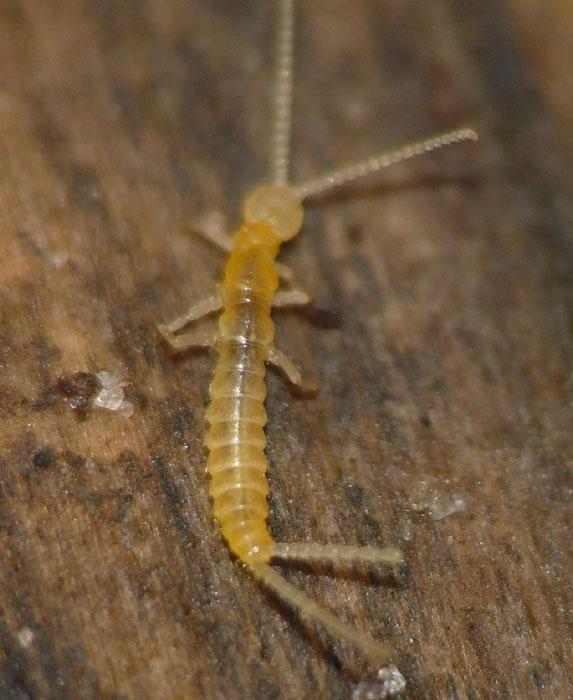Classification:
| Kingdom: | Animalia |
| Phylum: | Arthropoda |
| Order: | Diplura |
| Family: | Campodeidae |
| Genus: | Campodea |
| Species: | westwoodi |
Appearance: whitish or yellowish animals.
Structure: Their have no eyes, but they have a couple of antenna, which is trembling while it is moving . Their mouthpiece are "entotrophs" and their chewings and jaws aren’t connected to the outer wall of the head by a muscle, like other insects, but with basic parts connected to the inside of the head, so just the toe of it stretchs out. Lower lips are largely fused to the adjacent parts of the head. All Diplura have 3 segmented thorax, six legs, elongated, light colored and 10 segmented abdomen with two long “tail” (cerci) at the end of that.
They often does not have Malphigi-vessels. They use thin ventral bags outside their fine skin and tracheas for respiration, which are situated in pairs at both side of the abdomen and they are normally shirred. They are grown up in humid air by blood.
Habitat: They live in wet ground, stones, or under decaying plant parts, or in wet wood and that they don’t like the sunrise.
Dietary: Various degradable wastes, soft material of animals and plants.
The Campodea genus:
Campodea genus clearly show’s the attributes of Diplura: at the round, separated head there’re a pair of flexible distinct; at the thorax there’re 3 pairs of leg. With these it can run out fast, when it’s hideout is discovered. At the end of the ten segmented abdomen, there’re 2 long, angular, segmented tail, whose are sensible at tactile stimulus and it seems they functional by back antennas as well. In the middle of the lower (labium) lip witch is accreted to the neighboring parts of the head is situated a toe used an inside brim, behind it there’s a conic brim. The lower feelers are 2 short offshoot. On the mandible there are inside- and also outside- brims, ad a short feeler too. With these very small mouth organs, this animal can not eat or bite any solid thing. It must eat wet and soft nutritions of animals or plants. Behind the last pair of legs of the thorax, at the front of the abdomen, Campodea has a small cylindrical or conical leg witch is bigger on a male then on a female. At the second and seventh segment of the abdomen there are a pair of ventral bag on each sides. Next to its inside wall there is a long moveable bag. We can only see the back of the eleventh segment (it is where the two long tail connected to). The end of the body there’s the last segment called telson, witch contains a upper and a lower slab. We can say about the campodea’s inside structure that, it dosen’t have Malphigi-vessels. It is substituted by a 16 cellular ring witch is situated at the beginning of the rectum. Diplura’s respiration system is very simple. They have 3 pairs of stigma. One pair is on the front side, one pair in the middle, and one pair at the end of it. The tracheas from them are followed along to the head and the thorax. Other important respiration organs are the ventral bags too.
Racial specialites:
Campodea westwoodi lives under wet woods or putrefied old plats. So it dosen’t like the aqueous places, but it likes when its habitat wet enough. We can find it in forests in the mountain and also in plains. We can easily find a peace of it under wet leaves, rocks ore trees. It’s body is very flexible and thin. Length: 4 mm.
http://mek.niif.hu/03400/03408/html/2639.html (BREHM: AZ ÁLLATOK VILÁGA)
http://www.fugleognatur.dk/wildaboutdenmark/speciesintro.asp?ID=8563
http://en.wikipedia.org/wiki/Campodea
